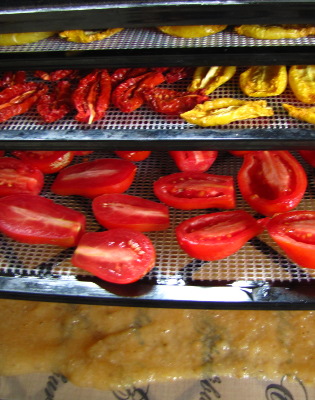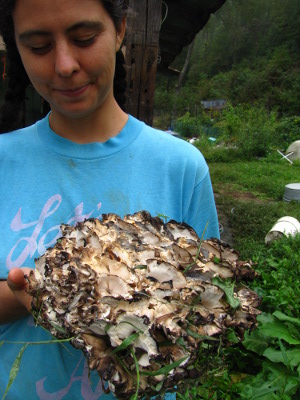
One season of food drying
 Has
our dehydrator paid for itself?
Probably not yet, but we've only had it around four months.
Has
our dehydrator paid for itself?
Probably not yet, but we've only had it around four months.
I've made about 6 cups
of dried mushrooms, 12 cups of dried summer squash, and 11 cups of
dried tomatoes. That doesn't sound like much, until you figure
that dried foods take up perhaps a quarter of the space of fresh foods,
so the dehydrator has processed around 7 gallons of vegetables already!
During peak tomato
drying season, I realized that I could slide in some fruit leather for Mark after the dryer had
been running for a couple of hours and kill two birds with one
stone. Tomato halves are a bit too tall to allow me to put a tray
on each shelf of the dehydrator, but they soon shrink down to more
moderate dimensions. Then I can add four trays of applesauce to
perk up my hard-working husband.
 We also learned that the
delicious (but extremely chewy) black-staining polypore mushroom can be
easily broken into tiny pieces after dehydrating. The result is
small enough chunks that you don't spend all afternoon chewing,
especially if you simmer the dried and powdered polypore for a few
hours in a pot of vegetable soup.
We also learned that the
delicious (but extremely chewy) black-staining polypore mushroom can be
easily broken into tiny pieces after dehydrating. The result is
small enough chunks that you don't spend all afternoon chewing,
especially if you simmer the dried and powdered polypore for a few
hours in a pot of vegetable soup.
Of course, the real
reason we got the dehydrator was to preserve homegrown fruit.
Strawberry season had just ended when we took the plunge, and if we'd
had the tool previously, I wouldn't have given away a couple of gallons
of berries and lost perhaps another half gallon to improper conditions
during one of my rounds of drying
in a sunny car.
(We still ended up putting away 23 cups of strawberry leather using the
car method, so it's hard to complain.) And then our peach tree
failed us, so we didn't have any summer fruit to dry. If our
strawberries and peaches bear well next year, then the dehydator will pay for
itself.
Want more in-depth information? Browse through our books.
Or explore more posts by date or by subject.
About us: Anna Hess and Mark Hamilton spent over a decade living self-sufficiently in the mountains of Virginia before moving north to start over from scratch in the foothills of Ohio. They've experimented with permaculture, no-till gardening, trailersteading, home-based microbusinesses and much more, writing about their adventures in both blogs and books.
Want to be notified when new comments are posted on this page? Click on the RSS button after you add a comment to subscribe to the comment feed, or simply check the box beside "email replies to me" while writing your comment.

We got an Excalibur dehydrator. If you follow the link, you'll see all of the pros and cons. In my experience, you're better off using your car than those cheap dehydrators you can often pick up at yard sales....
You might also be interested in my post about drying food with and without electricity, plus the rest of the lunchtime series linked to from the bottom of that post.